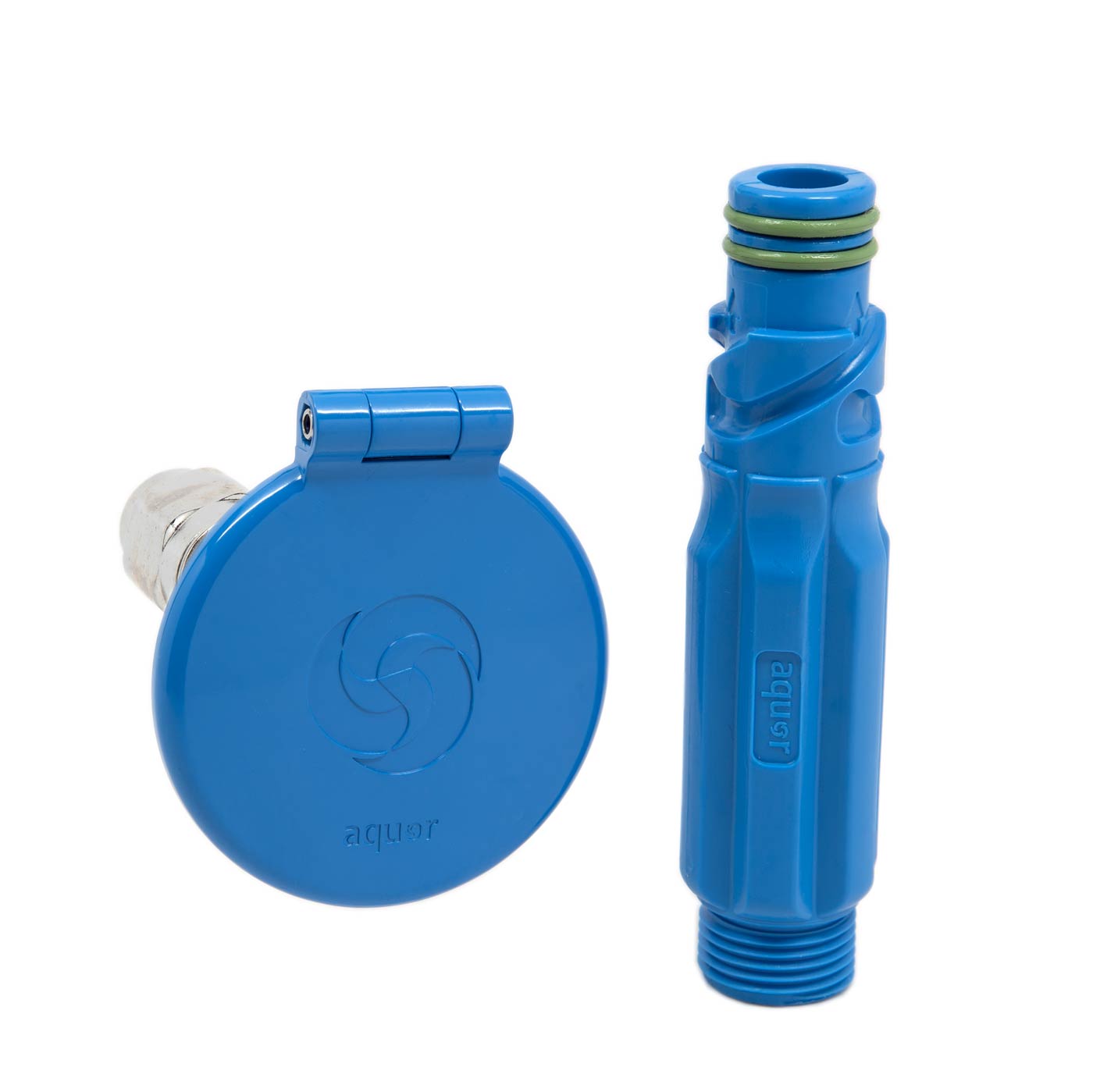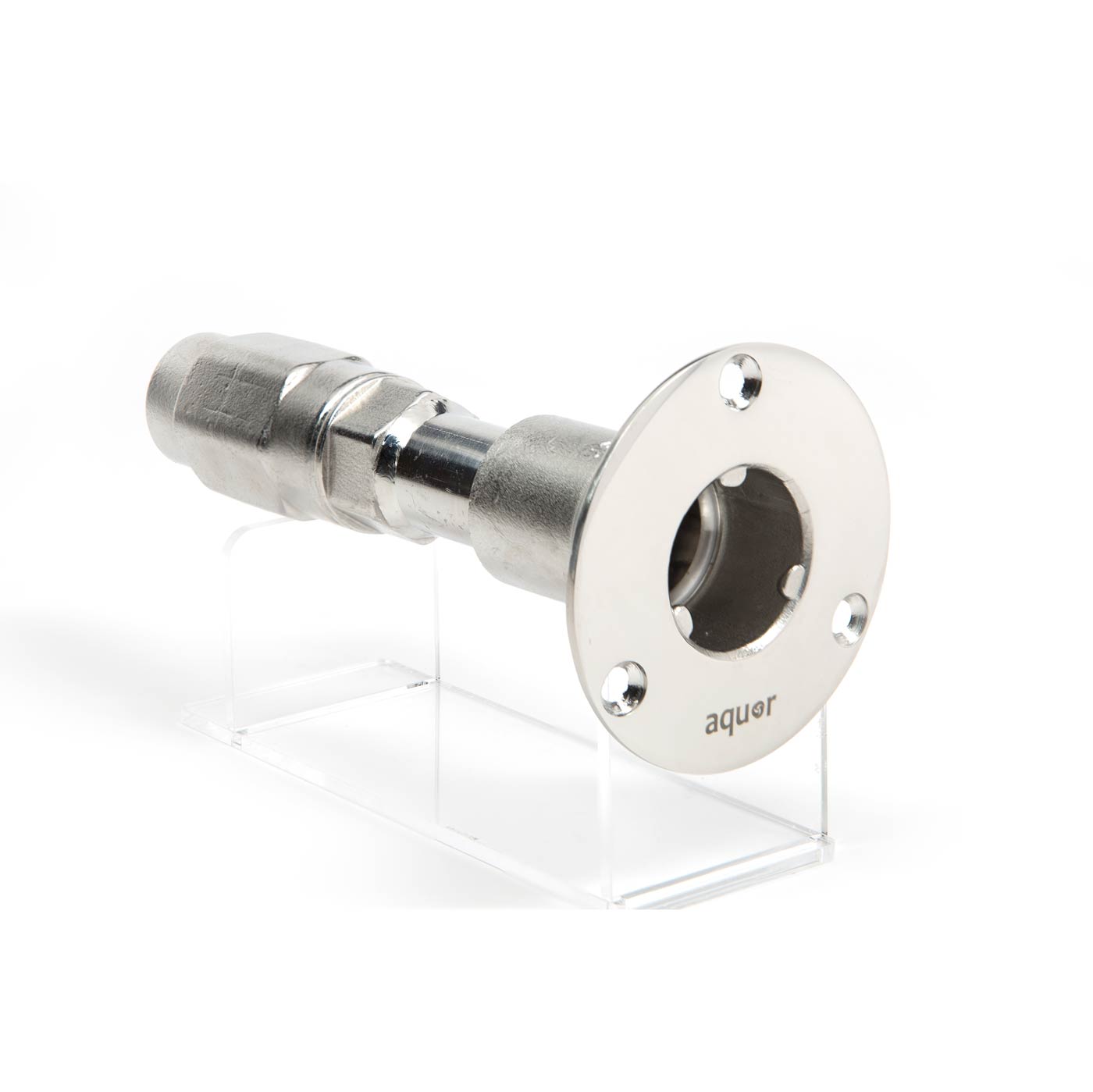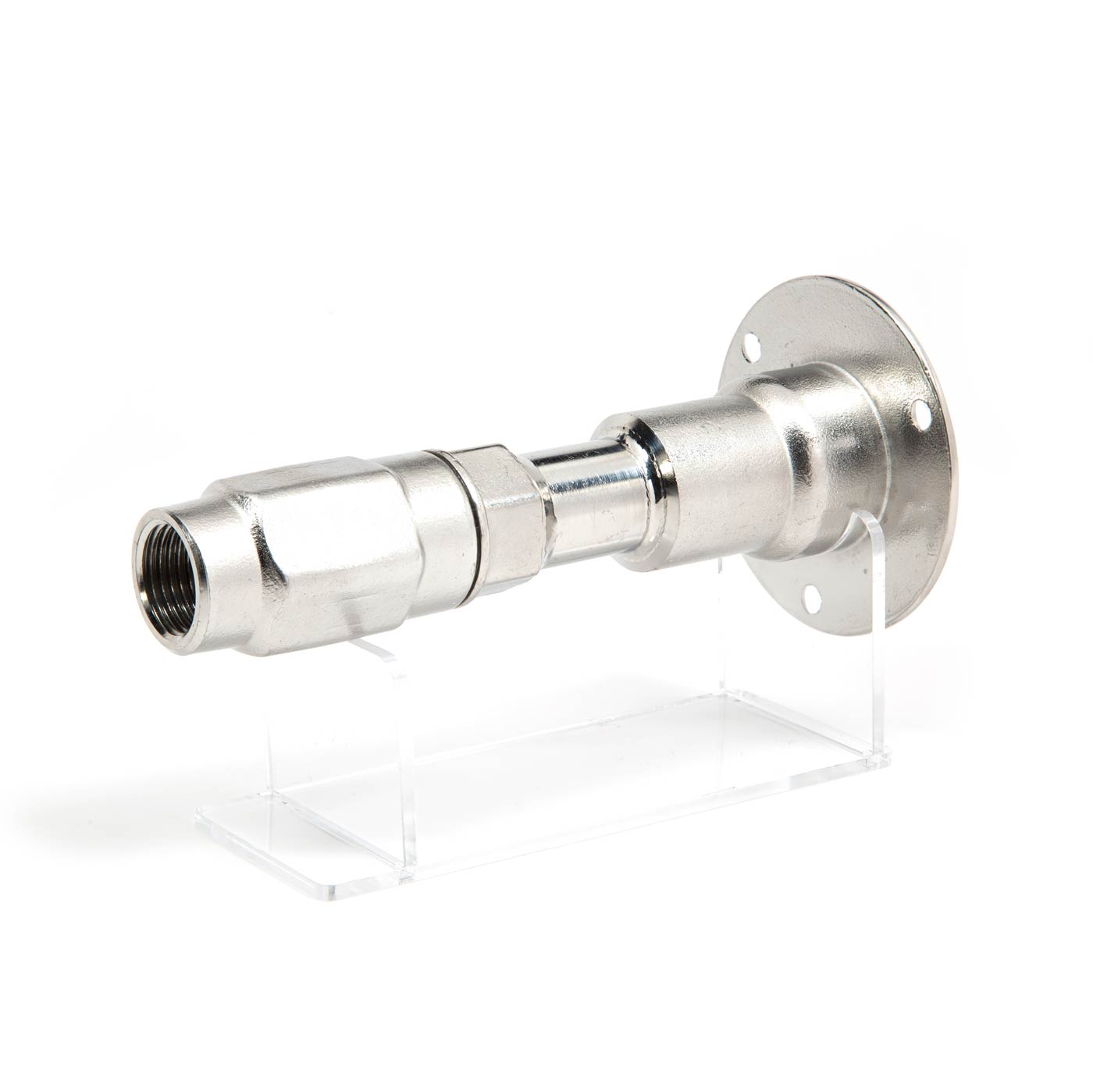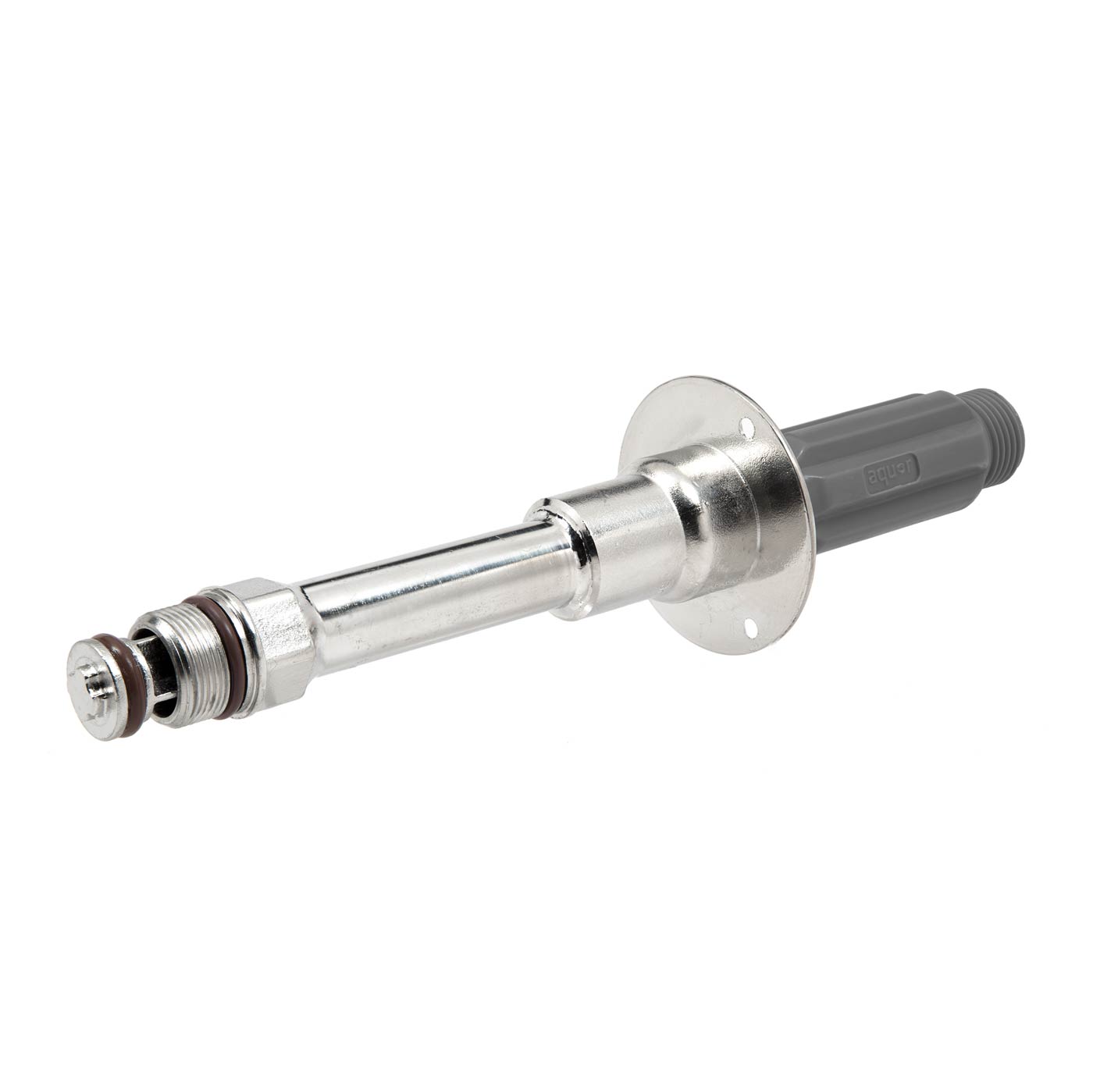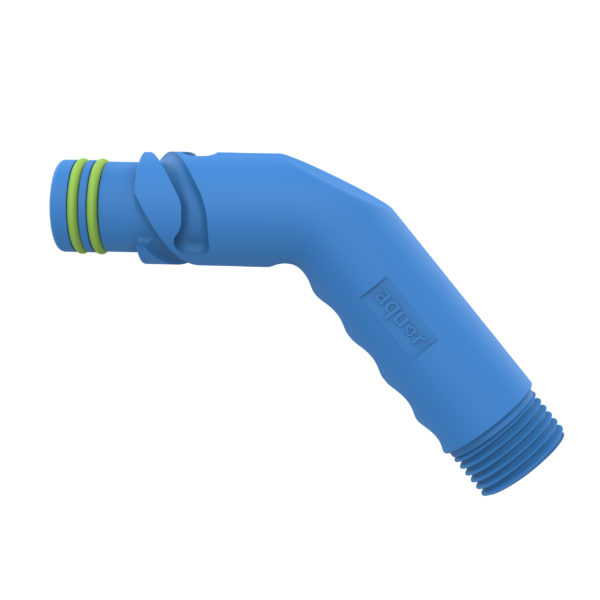Aquor® House Hydrant V1

Our original stainless steel House Hydrant.
Instant, Leak-Free Connections
Marine-Grade Stainless Steel
Sub-Zero Freeze Protection

Low-Profile Design
No-Hassle Security
100% Lead-Free
Multiple Finishes








HYDRANT SIZING

TECHNICAL SPECIFICATIONS
| Inlet | 1/2” NPT |
|---|---|
| Outlet | 3/4” Garden Hose Thread |
| Operating Temperature | 0° – 140° F |
| Operating Water Pressure | 25 – 125 PSI |
| Flow rate | 6.8 GPM @ 52 PSI |
| Plumbing Compatibility | All (PEX recommended) |
MORE DIMENSIONS

Compare Hydrants

House Hydrant V1
The V1 is our original hydrant. Ideal for most hose bib replacements. With a round entry hole and small footprint, it’s perfect for most residential retrofits.
Must be installed horizontally for drainage. Can be configured as inlet if needed. If new construction, code generally requires a vacuum breaker to be added. The V1 is ideal for concrete and brick installations due to its smaller, round entry hole.

House Hydrant V2 / V2+
The V2 series features a vacuum breaker integrated into the faceplate. A vacuum breaker prevents reverse flow of liquid, called backflow. Most plumbing codes now require backflow protection.
Ideal for any new construction. Meets latest plumbing codes in all 50 states with ASSE 1019 approval. Can be retrofitted. Must be installed horizontally for drainage.

Ground Hydrant
The Ground Hydrant has a special drainage valve that allows it to be installed vertically. It can be buried or installed into garden boxes or decks. It can be recessed, flush with the ground, or waist high. Bury the drainage port below the frost line for automatic freeze protection.
Ideal for any new construction, remodel, or general use. Connect to underground irrigation line.

Universal Outlet / Marine Deckwash
The Universal Outlet (and Marine Deckwash) can be mounted either vertically or horizontally. A black, impact-resistant swivel cover is used. The outlet installs flush against the mounting surface.
Can be modified to use as an intake.
Ideal for any general application, DIY project, deck, camper, marine, RV, and more.
Frequent Questions
Does the House Hydrant require installation?
Yes, the Aquor House Hydrant is a complete in-wall faucet system.
The installation process is very similar to that of a conventional in-wall outdoor faucet. A typical installation takes less than an hour per hydrant. The House Hydrant can be attached to any type of water supply line. Simply thread in any universal 1/2″ NPT adapter, depending on your type of plumbing (copper, PEX, CPVC, or other). For the quickest and easiest installation, we recommend using the House Hydrant with PEX tubing. With copper plumbing, the House Hydrant’s two-piece design allows for easier soldering than a standard sillcock.
Can I install the outlet vertically?
This hydrant is designed to be mounted horizontally only. The 5° wedge on the debris cover backplate angles the hydrant slightly, allowing it to self-drain.
If mounted vertically, the hydrant would not be able to drain. See our Marine Deckwash or Universal Outlet for mild-climate vertical applications, or the Ground Hydrant for a freezeproof vertical option.
How much clearance do I need for installation?
Check out the overall length of the hydrant, and then add a few inches for the plumbing fitting and supply line to fit. Our optional 90° elbow inlet shortens the total hydrant length by 1/2″, and no extra clearance is needed (because the supply line will be coming from the side). It replaces the back half of the outlet, and can be positioned in any direction.
What else do I need for installation?
You will need a 1.5″ hole saw, a 1/2″ NPT male-threaded plumbing adapter, teflon tape, and a philips screwdriver.
Plumbing adapters come in many forms, from crimp fittings to the “sharkbite” style you can simply push in. Each have their own pros and cons. We like using expansion adpaters with PEX, as they provide a balance of speed and reliability. An expander tool is used to stretch the PEX tubing, which then permanently shrinks over the fitting.
We highly recommend using a mounting block if possible. You want the hydrant as flush against your home’s wall as possible, so a flat and smooth mounting surface is ideal. You can buy one or make your own. If you would like us to offer pre-made mounting blocks or trim, please let us know. See our installation page for more info.
To use the hose connector that’s included with the House Hydrant kit, you’ll want to have a garden hose attached. Otherwise, you’ll likely get sprayed! Water flow starts instantly when you connect, so we recommend having a spray nozzle or other form of water regulator (such as a shutoff or Aquor Hose Adapter Kit) at the end of your hose.
If you want to access water without a garden hose, use our Removable Faucet accessory.
Will it prevent backflow?
The House Hydrant V1 has a one-way check valve in the connector that will prevent backflow. However, many new plumbing codes require an air gap, or vacuum breaker, to be present somewhere on your plumbing system.
We sell the V1 because many customers have vacuum breakers located on the main or elsewhere. Others use the V1 for general-use, clean potable water tanks, or other situations where backflow is not a risk.
You can attach any inline 3/4″ vacuum breaker (sold separately, available in any hardware store) to the end of the Aquor connector to meet plumbing code for new construction.
The House Hydrant V2 has an atmospheric vacuum breaker built into the faceplate for backflow protection with no reduction in flow. The House Hydrant V2 meets all ASSE 1019A backflow prevention requirements, and is approved for all 50 states.
How does the outlet work?
It’s a quick coupler system that engages under full pressure. With the Aquor hose connector attached to your garden hose, you simply push and twist into the outlet. The plunger-valve opens and water begins flowing instantly. There is no screw and flat rubber washer like a traditional brass valve. Viton® O-rings seal tighter under pressure for a reliable water-tight seal, every time. The reliable valve design is designed for decades of zero-maintenance, drip-free use.
Is the hose connector “plastic”? Will it break if I tug on it?
Our material choices are based on 15+ years of experience designing valves for marine applications. Aquor hose connectors are made from acetal resin, a heavy-duty commercial polymer. They can be used daily for years, are nearly crush-proof, and can withstand extremely high water pressures. Traditional brass hose bibs are certified to 100 lbs of lateral bending force. Our straight hose connector has been tested to 200+ lbs without breaking. If you are concerned about impact while connected, consider our Angled Hose Connector or Removable Faucet instead.
Will it provide freeze protection?
Yes. The House Hydrant is one the best freeze-proof outdoor faucet systems in the world.
The Hydrant stops water flow inside the heated portion of your wall, where it remains insulated and protected against freezing. Stainless steel also provides significantly better insulation than brass, and will outperform any brass frost-free sillcock.
We have tested the system to -30° F with no additional covers. However at those extremes, the hydrant is only as good as your exterior wall insulation. With proper wall insulation, you’ll never need to winterize or cover the House Hydrant.
How do I attach accessories such as vacuum breakers, timers, or splitters?
Any accessory with a standard 3/4″ hose fitting can be attached directly to the Aquor connector, like you would to the end of a standard outdoor faucet.
Y-splitters, water timers, vacuum breakers, and other accessories all work great with the Aquor system. Use multiple Aquor connectors to quickly swap accessories out without needing to unscrew them.
Can I leave it connected year-round?
The House Hydrant system should be left disconnected when not in use. It is not intended to be left in continuous use.
Disconnecting allows the hydrant to self-drain. Without draining, the House Hydrant cannot offer freeze protection. Leaving a hose connected in freezing temperatures when not in use may cause damage.
Leaving your garden hose pressurized for extended periods could damage nozzles or accessories, especially if the water inside heats up and expands. Just disconnect and give your nozzle a quick squeeze to release pressure. We’ve made it as easy as possible to do!
How do I regulate flow?
We designed the Aquor connector with the fewest moving parts to be as simple and reliable as possible.
Because regulator valves would be the first point of failure, we decided not to integrate them. For an easy way to regulate pressure, you can attach any standard inline ball valve to the end of the Aquor connector.
Our Removable Faucet accessory has a ball valve built-in for flow control. You can use it with or without a garden hose.





